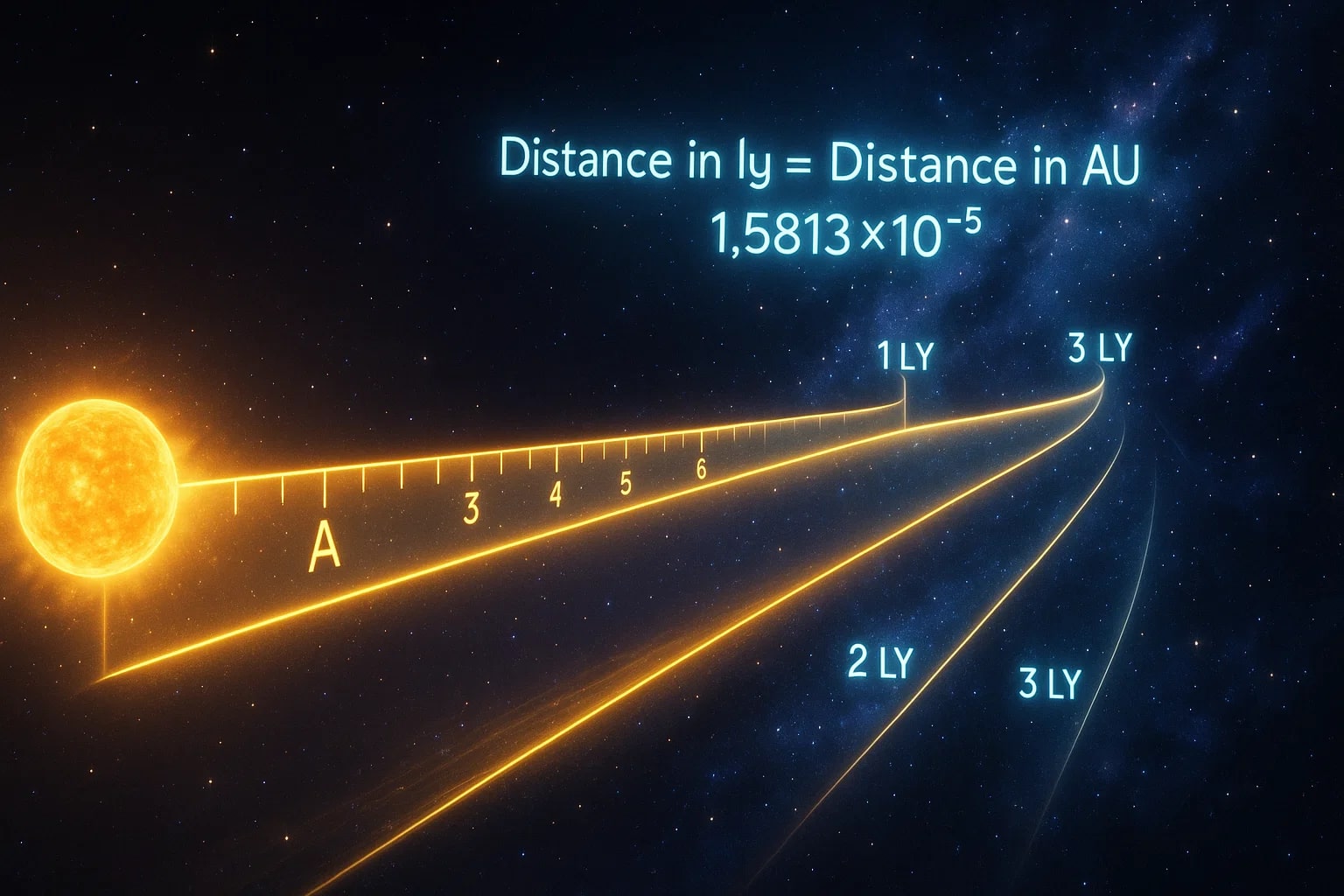astronomical unit to light year – How to convert AU to ly
The astronomical unit to light year conversion takes you from our own solar neighborhood to the vast distances between stars. Astronomical units are perfect for describing the scale of planets and comets around the Sun, while light years help us talk about the distances to stars, galaxies, and beyond.

Astronomical units and light years in perspective
An astronomical unit (AU) is the average distance between the Earth and the Sun — about 149 597 870.7 kilometers. Astronomers use it to make solar system distances easier to express. For example, Jupiter is about 5.2 AU from the Sun.
A light year (ly) is the distance light travels in a vacuum in one year — about 9.46 trillion kilometers. It’s the go-to unit for interstellar and intergalactic distances.
Because both units measure distance but on vastly different scales, converting between them gives you a sense of just how small our solar system is compared to the galaxy.
Formula examples:
1 AU ≈ 1.5813×10⁻⁵ ly
1 ly ≈ 63 241.1 AU
How to convert astronomical unit to light year
The formula is:
Distance in ly = Distance in AU × 1.5813×10⁻⁵
Example:
If Neptune orbits about 30.07 AU from the Sun:
30.07 × 1.5813×10⁻⁵ ≈ 0.000475 ly
That’s less than five ten-thousandths of a light year — a reminder that even the edge of our solar system is tiny compared to the distances between stars.
If you don’t want to do the math, Jetcalculator’s Conversion Tools will handle AU to ly and other space-related conversions instantly.
Did you know?
-
The astronomical unit is based on the mean Earth–Sun distance, but its definition was fixed in meters in 2012 for precision.
-
A light year isn’t a measure of time — it’s a measure of distance, though the name can be misleading.
-
Proxima Centauri, the nearest star beyond the Sun, is about 4.24 light years away — or about 268 770 AU.
-
The Oort Cloud, a distant region of icy bodies surrounding our solar system, may extend up to 100 000 AU from the Sun, or roughly 1.58 light years.
-
The Voyager 1 spacecraft, launched in 1977, has traveled over 160 AU — but that’s still only 0.0025 light years.
-
One AU is about 8 minutes and 20 seconds of light travel time, so when we look at the Sun, we see it as it was just over eight minutes ago.
-
The term “light year” gained popularity in the early 20th century as astronomy reached farther into deep space.
-
Using AU for solar system distances keeps numbers smaller, while light years are more practical for mapping the galaxy.
The journey of New Horizons
NASA’s New Horizons spacecraft, famous for its flyby of Pluto in 2015, is a great example of why AU and light year conversions matter. At launch, mission updates gave distances in AU — Pluto’s orbit is about 39.5 AU from the Sun.
After passing Pluto, New Horizons continued toward the Kuiper Belt. Mission scientists noted its speed and position in AU for most updates, but in public outreach materials, they sometimes converted the numbers to light years to give people a sense of scale.
When it reached 50 AU from the Sun, that worked out to about 0.00079 light years — still only a tiny step toward the nearest stars. Using both units helped communicate the spacecraft’s progress to audiences with different levels of astronomical knowledge.

Connecting two cosmic scales
The astronomical unit to light year conversion is a bridge between the solar system and the galaxy. Astronomical units are like a “local map” for our solar neighborhood, while light years are the “interstellar atlas” for deep space.
Understanding both — and how to convert between them — lets you compare the familiar distances we can travel with spacecraft to the unimaginably large distances we can only explore with telescopes.
So the next time you read that an object is 500 AU away, you’ll know it’s roughly 0.0079 light years — still close by cosmic standards, but far beyond the reach of today’s spacecraft.

